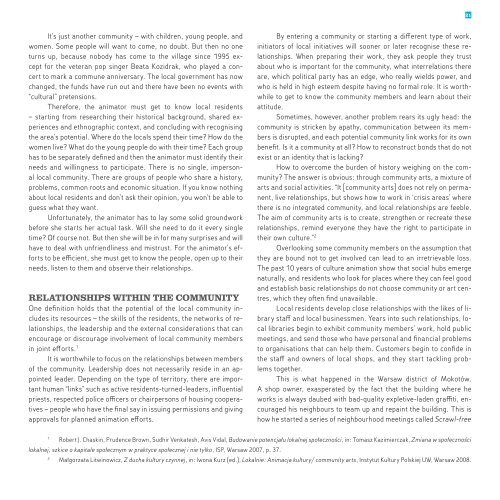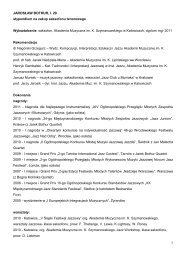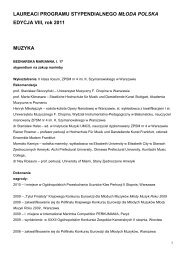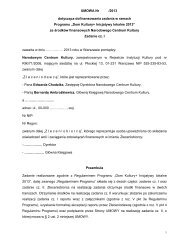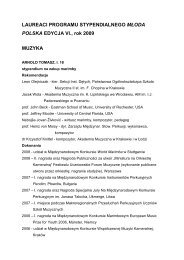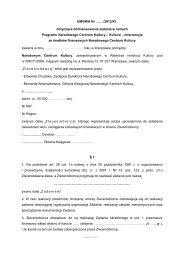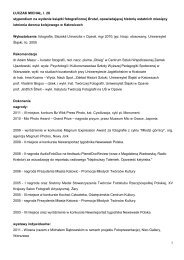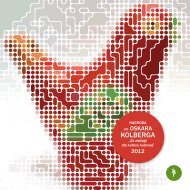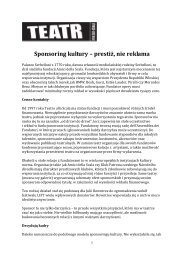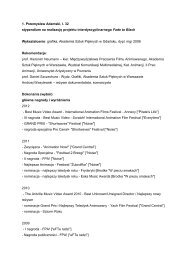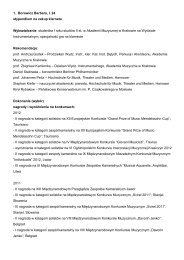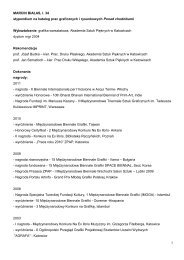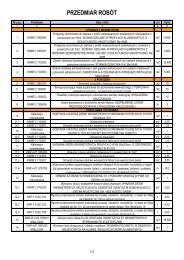Untitled - Narodowe Centrum Kultury
Untitled - Narodowe Centrum Kultury
Untitled - Narodowe Centrum Kultury
You also want an ePaper? Increase the reach of your titles
YUMPU automatically turns print PDFs into web optimized ePapers that Google loves.
tytuł artykułu 21<br />
It’s just another community – with children, young people, and<br />
women. Some people will want to come, no doubt. But then no one<br />
turns up, because nobody has come to the village since 1995 except<br />
for the veteran pop singer Beata Kozidrak, who played a concert<br />
to mark a commune anniversary. The local government has now<br />
changed, the funds have run out and there have been no events with<br />
“cultural” pretensions.<br />
Therefore, the animator must get to know local residents<br />
– starting from researching their historical background, shared experiences<br />
and ethnographic context, and concluding with recognising<br />
the area’s potential. Where do the locals spend their time How do the<br />
women live What do the young people do with their time Each group<br />
has to be separately defined and then the animator must identify their<br />
needs and willingness to participate. There is no single, impersonal<br />
local community. There are groups of people who share a history,<br />
problems, common roots and economic situation. If you know nothing<br />
about local residents and don’t ask their opinion, you won’t be able to<br />
guess what they want.<br />
Unfortunately, the animator has to lay some solid groundwork<br />
before she starts her actual task. Will she need to do it every single<br />
time Of course not. But then she will be in for many surprises and will<br />
have to deal with unfriendliness and mistrust. For the animator’s efforts<br />
to be efficient, she must get to know the people, open up to their<br />
needs, listen to them and observe their relationships.<br />
relationships within the community<br />
One definition holds that the potential of the local community includes<br />
its resources – the skills of the residents, the networks of relationships,<br />
the leadership and the external considerations that can<br />
encourage or discourage involvement of local community members<br />
in joint efforts. 1<br />
It is worthwhile to focus on the relationships between members<br />
of the community. Leadership does not necessarily reside in an appointed<br />
leader. Depending on the type of territory, there are important<br />
human “links” such as active residents-turned-leaders, influential<br />
priests, respected police officers or chairpersons of housing cooperatives<br />
– people who have the final say in issuing permissions and giving<br />
approvals for planned animation efforts.<br />
By entering a community or starting a different type of work,<br />
initiators of local initiatives will sooner or later recognise these relationships.<br />
When preparing their work, they ask people they trust<br />
about who is important for the community, what interrelations there<br />
are, which political party has an edge, who really wields power, and<br />
who is held in high esteem despite having no formal role. It is worthwhile<br />
to get to know the community members and learn about their<br />
attitude.<br />
Sometimes, however, another problem rears its ugly head: the<br />
community is stricken by apathy, communication between its members<br />
is disrupted, and each potential community link works for its own<br />
benefit. Is it a community at all How to reconstruct bonds that do not<br />
exist or an identity that is lacking<br />
How to overcome the burden of history weighing on the community<br />
The answer is obvious: through community arts, a mixture of<br />
arts and social activities. “It [community arts] does not rely on permanent,<br />
live relationships, but shows how to work in ‘crisis areas’ where<br />
there is no integrated community, and local relationships are feeble.<br />
The aim of community arts is to create, strengthen or recreate these<br />
relationships, remind everyone they have the right to participate in<br />
their own culture.” 2<br />
Overlooking some community members on the assumption that<br />
they are bound not to get involved can lead to an irretrievable loss.<br />
The past 10 years of culture animation show that social hubs emerge<br />
naturally, and residents who look for places where they can feel good<br />
and establish basic relationships do not choose community or art centres,<br />
which they often find unavailable.<br />
Local residents develop close relationships with the likes of library<br />
staff and local businessmen. Years into such relationships, local<br />
libraries begin to exhibit community members’ work, hold public<br />
meetings, and send those who have personal and financial problems<br />
to organisations that can help them. Customers begin to confide in<br />
the staff and owners of local shops, and they start tackling problems<br />
together.<br />
This is what happened in the Warsaw district of Mokotów.<br />
A shop owner, exasperated by the fact that the building where he<br />
works is always daubed with bad-quality expletive-laden graffiti, encouraged<br />
his neighbours to team up and repaint the building. This is<br />
how he started a series of neighbourhood meetings called Scrawl-free<br />
1<br />
Robert J. Chaskin, Prudence Brown, Sudhir Venkatesh, Avis Vidal, Budowanie potencjału lokalnej społeczności, in: Tomasz Kazimierczak, Zmiana w społeczności<br />
lokalnej, szkice o kapitale społecznym w praktyce społecznej i nie tylko, ISP, Warsaw 2007, p. 37.<br />
2<br />
Małgorzata Litwinowicz, Z ducha kultury czynnej, in: Iwona Kurz (ed.), Lokalnie: Animacja kultury/ community arts, Instytut <strong>Kultury</strong> Polskiej UW, Warsaw 2008.


